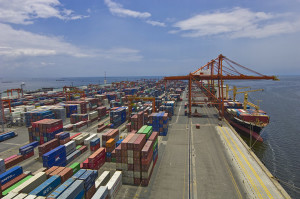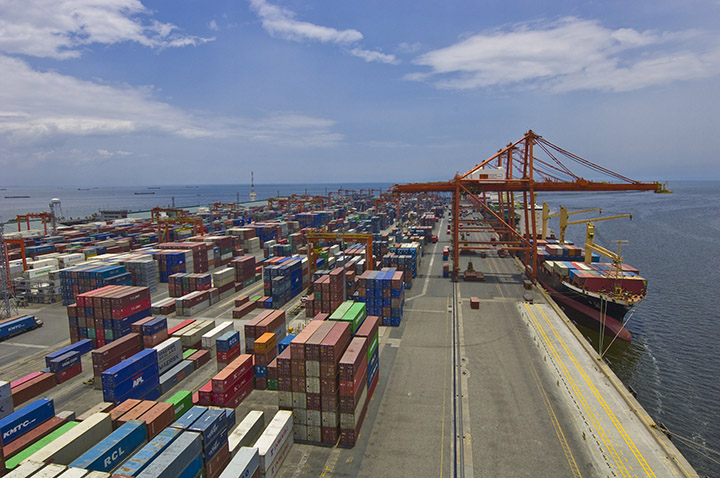 Foreign shipping lines have started to lift their port congestion charges, while trucking charges have gone back to pre-Manila truck ban levels in a sign that port congestion has been licked, according to government officials.
Foreign shipping lines have started to lift their port congestion charges, while trucking charges have gone back to pre-Manila truck ban levels in a sign that port congestion has been licked, according to government officials.
Cabinet Secretary Jose Rene Almendras, who is also the chairman of the Cabinet Cluster on Port Decongestion, on April 13 said, “Congestion is completely over at Manila International Container Ports despite higher than normal volumes handled during the first quarter of this year.”
He said, “A number of carriers calling at MICT (Manila International Container Terminal) have removed their ‘Port Congestion and other Surcharges.’ This was a charge implemented by the carriers at the time congestion was experienced at the Port of Manila.”
He added this “proves beyond doubt that there is no more congestion at the Manila International Container ports, thus the charge no longer needs to be implemented.”
He noted other shipping lines are seeking approval from their regional headquarters to drop their surcharges within the month.
“We also look forward to the return of trucking rates to its normal levels prior to the congestion,” Almendras said.
Almendras’ statement mirrors that of Department of Trade and Industry (DTI) Consumer Protection Group Undersecretary Atty. Victorio Mario Dimagiba’s who, in a text message on April 12, said: “We are happy to announce that these charges (port congestion and trucking) had been reversed or withdrawn or rolled back to pre-port congestion level and (to) market competition at work.”
The lifting of port congestion charges by some foreign carriers was confirmed by Association of International Shipping Lines (AISL) president Patrick Ronas in a text message to PortCalls. He added other carriers will also follow suit.
Dimagiba claimed 12 shipping lines have lifted their port congestion surcharges, namely, APL, Maersk Line, MCC Transport, Wan Hai Lines, Yang Ming, Sinotrans, TS Lines, Hapag-Lloyd, CMA CGM, SITC, COSCO, and Alexandria Lines.
Dimagiba added three businessmen have also filed complaints with DTI against three companies—one shipping line and two ship agents—for a refund of port congestion charges. DTI said it mediated and the results favored the businessmen.
Philippine International Seafreight Forwarders Association, Inc. (PISFA) president Mariz Regis, in a letter to AISL dated April 10, said PISFA is closely monitoring the situation at Manila ports even as she said association members have observed considerable improvements.
“Categorically speaking, there is no sign of any congestion anymore,” Regis said.
PISFA sought AISL’s help to look into why its member carriers, even with the easing of port congestion, are still imposing port congestion surcharges and emergency recovery surcharges.
In her advisory to PISFA members, Regis attached SITC Container Lines and China Shipping notices regarding the lines’ scrapping of port congestion surcharges.
SITC has cancelled its port congestion surcharge for shipments from ports of China mainland, Taiwan, Thailand, and Vietnam to Manila and Subic but increased its emergency cost recovery charge.
China Shipping scrapped its port congestion surcharge to Manila from mainland China, Taiwan, Hong Kong, Korea, Japan, Middle East, New Zealand, Australia, Red Sea and Southeast Asia but also hiked its emergency cost recovery charge.
As of press time, other international shipping lines have yet to officially confirm cancellation of their port congestion surcharges.
On trucking charges, DTI said Confederation of Truckers Association of the Philippines director Alberto Suansing has said the suggested trucking rate in the National Capital Region is now P14,000 on average.
Last year, truckers increased their rates by as much as 50% after the Manila City truck ban was implemented, citing the slow turnaround from the limited road travel window, while shipping lines imposed a port congestion surcharge to cover losses from waiting for weeks to berth.
Dimagiba said that from March 28 to April 8, no vessels were waiting in line to berth at Manila ports. Within the period, the MICT and Manila South Harbor together processed 104,583 twenty-foot equivalent units (TEUs), of which 51,973 were discharged from and 52,610 were loaded onto vessels.
The two terminals also serviced a total of 91,097 trucks in and out of their gates. Of this, 45,174 TEUs of imports were released during the last two weeks while 45,923 TEUs were received for loading.
Yard utilization at MICT was 60.61% and 63.17% for the last two weeks. Utilization at Manila South Harbor’s laden yard was 53.51% and 46.91%, while its empty-box yard was 47.76% and 62.9% utilized.
With the rollback, Dimagiba said “prices of basic and prime (commodities) had remained very steady and were lower than SRPs (suggested retail prices) as DTI had completed monitoring of all 376 supermarket and groceries in the first quarter of the year.”
Meanwhile, Ronas said the Web-based empty container return application is now up and running and being tested by three carriers. The application was hatched last year to resolve the issue of delays in the return of empty containers, which worsened during port congestion.
Moreover, asked if carriers have repositioned their empty containers as ordered by a new directive from the Bureau of Customs (BOC), Ronas said there is no information yet on this, but “I feel the lines have moved them already, otherwise they will be scrambling to go to Subic.”
BOC in January this year issued Customs Administrative Order No. 01-2015, which cut dwell time for foreign empty containers in the country from 150 days to 90 days. Carriers that fail to comply will have their empties considered as imports and slapped with duties and taxes.
Under the CAO, empty containers re-exported on or before April 30, regardless of when they arrived in the Philippines, will not be levied duties or taxes. Containers arriving as empty from January 30 until April 30 should be re-exported by July 29.
Likewise, containers stuffed with imported cargoes which were returned to the shipping line at any time from January 30 to April 30, as evidenced by the Equipment Interchange Receipt (EIR) issued by the carrier and signed by the party receiving or delivering the containers, should also be re-exported by July 29.
From May 1 onwards, empty containers arriving in the country should be re-exported within 90 days from date of last discharge. Likewise, containers with imported cargoes must be re-exported within 90 days after their return to the shipping line, based on the EIR.
And from May 1 onwards, any container not re-exported within 90 days from date of last discharge (for containers that arrived as empties), or from date of its return to the shipping line (for containers which arrived with cargo), as evidenced under the EIR, will be subject to duties and taxes. – Roumina Pablo





